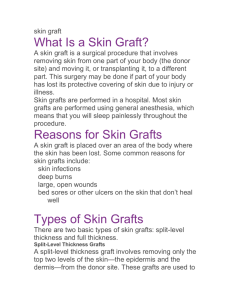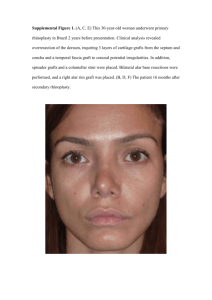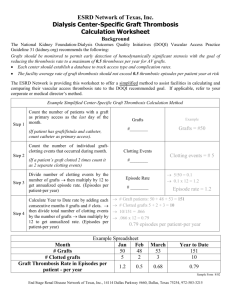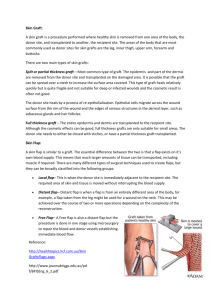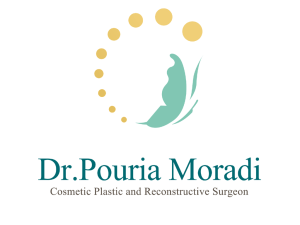Full-Thickness Grafts - Advanced Foot & Ankle Specialists
advertisement
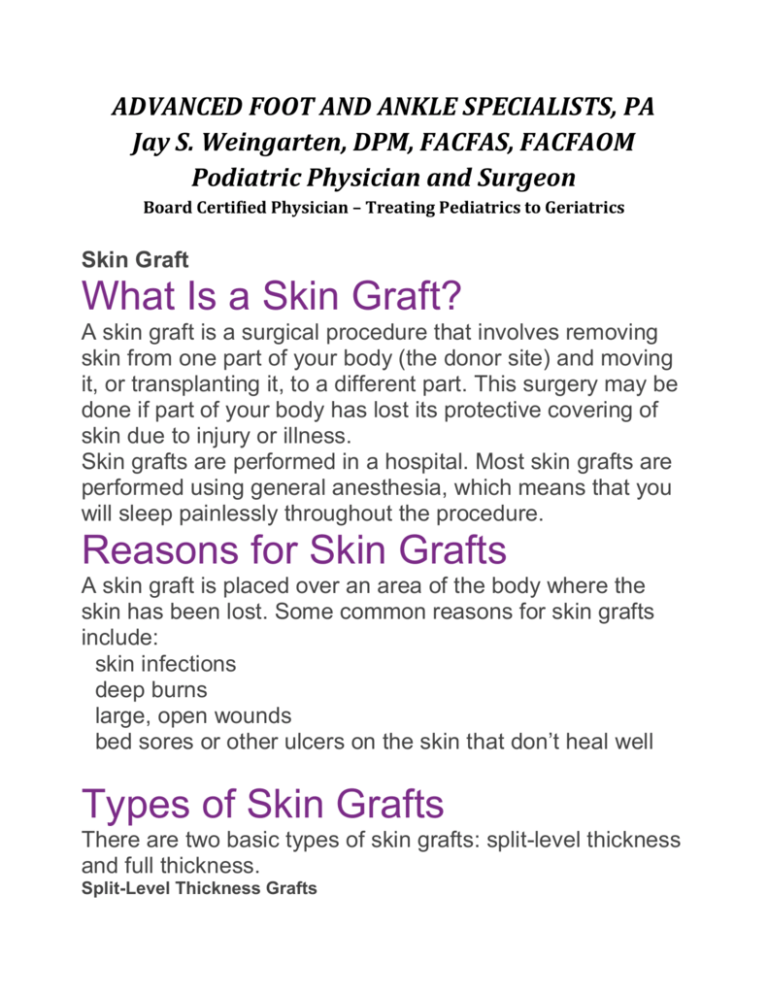
ADVANCED FOOT AND ANKLE SPECIALISTS, PA Jay S. Weingarten, DPM, FACFAS, FACFAOM Podiatric Physician and Surgeon Board Certified Physician – Treating Pediatrics to Geriatrics Skin Graft What Is a Skin Graft? A skin graft is a surgical procedure that involves removing skin from one part of your body (the donor site) and moving it, or transplanting it, to a different part. This surgery may be done if part of your body has lost its protective covering of skin due to injury or illness. Skin grafts are performed in a hospital. Most skin grafts are performed using general anesthesia, which means that you will sleep painlessly throughout the procedure. Reasons for Skin Grafts A skin graft is placed over an area of the body where the skin has been lost. Some common reasons for skin grafts include: skin infections deep burns large, open wounds bed sores or other ulcers on the skin that don’t heal well Types of Skin Grafts There are two basic types of skin grafts: split-level thickness and full thickness. Split-Level Thickness Grafts A split-level thickness graft involves removing only the top two levels of the skin—the epidermis and the dermis—from the donor site. These grafts are used to cover large areas. Split-level grafts tend to be fragile and have a shiny or smooth appearance. They may also appear paler than the adjoining skin. Full-Thickness Grafts A full thickness graft involves removing the muscles and blood vessels as well as the top layers of skin from the donor site. Full-thickness grafts are generally used for small wounds on a highly visible part of the body, such as the face. Unlike split-level thickness grafts, they blend in well with the skin around them and usually grow with the individual. Skin Graft Preparation You may need to stop taking certain medications, such as aspirin, that interfere with the blood’s ability to form clots. You should minimize stair climbing immediately after the surgery and plan to have someone to stay with you to help take care of you during your first few days at home. Your doctor will tell you not to eat or drink anything after midnight on the day of the surgery. Skin Graft Procedure You will arrive at the hospital on the morning of the surgery. A nurse or a technician will help you get ready for the operation by giving you a hospital gown to wear in place of street clothes and starting an IV in your hand, arm, or wrist. The IV allows your doctors to give you medicine and fluids during and after the surgery. When it is time for your operation, you will be taken into the operating room. Once you are in the operating room, a doctor will inject a medicine into your IV line. The medicine, called general anesthetic, will make you fall asleep and stay asleep throughout the surgery so that you don’t feel any pain. The surgeon will begin the operation by removing skin from the donor site. If you are getting a split-level thickness graft, the skin will be removed from an area of your body that is usually hidden by clothes, such as your hip or the inside of your thigh. If you are getting a full-thickness graft, the preferred donor sites are the abdominal wall or the chest wall. Once the skin is removed from the donor site, the surgeon carefully places it over the transplant area and fixes it in place with a surgical dressing, staples, or stitches. He or she will also cover the donor area with a dressing that won’t stick to the wound. Aftercare for a Skin Graft You will wake up in the recovery room. The staff will watch you closely after surgery, monitoring your vital signs and giving you medications to manage pain. When the staff is sure you are stable, you will be taken to a hospital room to continue your recovery. The graft should start developing blood vessels to connect it with the skin around it within 36 hours. If these blood vessels do not begin to form, it could be a sign that your body is rejecting the graft. You may hear doctors say that the graft “hasn’t taken.” If the graft doesn’t take, you may require another operation and a new graft. Your doctor will probably discharge you with a prescription for painkillers and instructions about how to care for the graft site and the donor site to avoid infection. Avoid activities that stretch or pull the graft site for at least three to four weeks. The donor site will heal within two to three weeks. Your doctor will tell you when it is safe to resume your normal activities. 1233 SE Indian St., Suite 102, Stuart, FL 34997 tel. 772-223-8313, fax 772-223-8675 1106 W Indiantown Rd, Suite 4, Jupiter, FL 33458 tel. 561-744-6683, fax 561-744-7033

